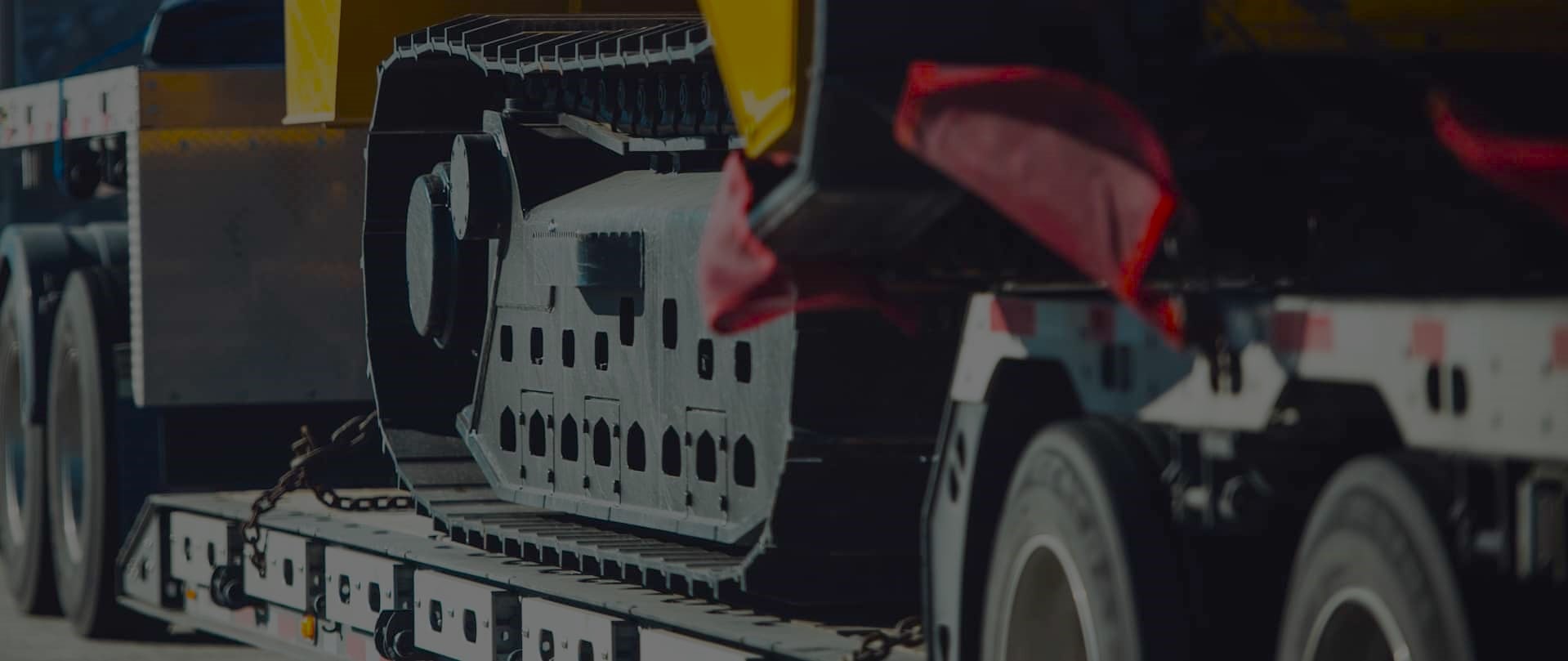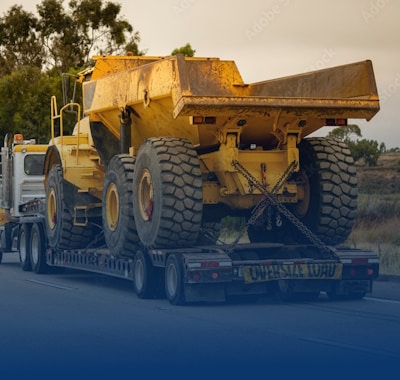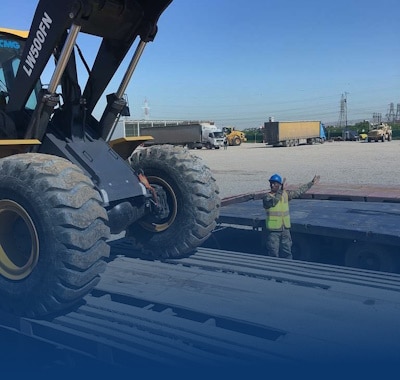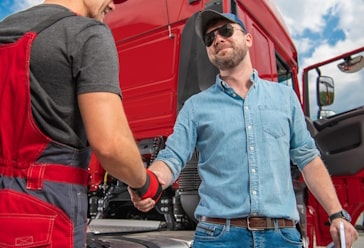Optimized Crane Transport for Heavy Load Logistics
Freedom Heavy Haul can offer expedited Pickup and Delivery for any size shipment anywhere in the USA. Contact us today for No Hassle, No Pressure Pricing.
When you enter the world of heavy load logistics, knowing about optimized crane transport is key. It’s not just good; it’s necessary for construction, manufacturing, and oil and gas. Using crane transport with the best routes can make your operations much better.
This approach cuts down costs and boosts safety. It also makes sure deliveries are on time. As you read on, you’ll learn about the important parts of good logistics. You’ll see how they change the industry.
Key Takeaways
- Understanding crane transport’s role in heavy load logistics.
- The necessity of efficient oversized cargo transport.
- Importance of reducing operational costs.
- Enhancing safety measures within transportation.
- Timely deliveries as a critical factor in logistic solutions.
- Framework for further exploration of heavy load logistics components.
Understanding Heavy Load Logistics
Heavy load logistics is about moving big or heavy items safely. It needs special transport solutions. Knowing what’s considered heavy is key to following safety rules and running logistics smoothly.
What Constitutes Heavy Loads?
Heavy loads are defined by weight and size. These rules can change based on where you are. But, anything over 10,000 pounds is usually heavy. Size matters too, especially if it’s bigger than what regular trucks can handle.
Here are some common size and weight limits:
- Weight: Often defined as exceeding 10,000 pounds
- Width: Loads wider than 8.5 feet
- Height: Loads taller than 13.5 feet
- Length: Loads longer than 40 feet
Importance of Specialized Transport
Specialized transport is vital for heavy loads. It makes sure things are safe, efficient, and follow all rules. Vehicles like low loaders and modular trailers are built for strength and stability.
Here are some benefits:
- Reduced risk of damage during transit
- Increased transport efficiency with tailored routes
- Improved regulatory compliance through proper documentation and permits
Using specialized transport is crucial for handling heavy loads well. It helps you deal with the challenges of moving big items safely.
Crane Transport with Optimized Routes for Heavy Load Logistics
Crane transport with optimized routes is key for managing heavy loads. It boosts efficiency a lot. Knowing the benefits of route optimization helps in making smart transport choices.
Benefits of Optimized Routes
Optimized routes bring many advantages:
- Reduced travel time: Better routes mean faster deliveries, helping you meet deadlines.
- Lower fuel costs: Shorter distances save a lot on fuel.
- Enhanced safety management: Safe route planning lowers accident risks, keeping you in line with safety rules.
Key Considerations for Route Optimization
When planning routes for crane transport, think about these:
- Topography: Study the terrain to find the best paths for heavy loads.
- Legal restrictions: Know local laws that might limit routes, like height or weight limits.
- Potential hazards: Look at environmental factors like road conditions and traffic that could affect safety.
Using tech for route planning can make things even better. Real-time tracking lets you adjust routes as needed, keeping deliveries efficient.
Choosing the Right Crane for the Job
Choosing the right crane for your heavy load project is key for safety and efficiency. Knowing the different cranes can help you make a smart choice. Each crane has its own role, so it’s important to match your project needs.
Types of Cranes for Heavy Loads
There are many cranes for different project needs. Here are a few common ones:
- Crawler Cranes: Great for rough terrain, these cranes have tracks for stability and can lift heavy loads.
- Fixed Cranes: These are stationary and used in construction for vertical lifting over long periods.
- Truck-Mounted Cranes: Very versatile, these cranes can move quickly between sites and are mounted on trucks.
Knowing about these cranes helps you pick the right one for your heavy load needs.
Factors to Consider in Crane Selection
When picking a crane, consider these key factors for the right choice:
- Load Capacity: Check the crane’s max load to avoid any issues during your project.
- Height Restrictions: Look at the vertical clearance needed for your load to fit the site.
- Site Accessibility: Think about the space for crane operation and any obstacles.
By considering these factors, you can pick a crane that fits your project needs for safe and efficient work.
The Role of Route Planning Software
Adding route planning software to your heavy load logistics can change your game. It offers key tools for better route planning, helping you tackle challenges and stay compliant. Knowing what these solutions offer makes picking the right one easier.
Features of Effective Route Planning Solutions
When looking at route planning software, search for important features:
- Real-Time Updates: It should track loads and change routes as needed.
- Mapping Capabilities: It should have detailed maps showing different routes and obstacles.
- Predictive Analytics: It should use data to predict traffic and delays.
- Integration With Existing Systems: It should work well with other logistics tools.
How to Choose the Right Software
Picking the right route planning software takes thought. First, think about your logistics challenges and what’s most important to you. Consider these points:
- Functionality: Make sure it fits your heavy load transport needs.
- User-Friendly Interface: It should be easy for your team to use.
- Customer Support: Good support is key for help and advice.
- Cost-Effectiveness: Check if the price fits your budget.
By keeping these tips in mind, you can boost your operations. This leads to better crane transport and overall logistics efficiency.
Logistics Management Systems and Their Importance
Logistics management systems are key in transport operations. They offer advanced solutions that boost project execution and performance. These systems use technology to ensure smooth coordination and information flow among stakeholders in heavy load logistics.
Integration with Transport Operations
Integrating logistics management systems with transport operations changes project management. This approach allows for real-time tracking of shipments. It helps in making better decisions and allocating resources effectively.
For example, if transport operations face challenges, the LMS can offer insights for quick adjustments. This keeps the process flowing smoothly.
Improving Efficiency through Technology
Technology is crucial for improving logistics efficiency. Logistics management systems include features like automated reporting and analytics. These features speed up responses and reduce errors.
By using these systems, you can make your transport operations more efficient. This saves time and money.
Heavy Haul Trucking Explained
Knowing when you need heavy haul trucking is key to good logistics planning. It’s for shipping big loads that are too heavy or too big for regular trucks. The size, weight, and how far you need to move it decide if you need special trucks.
When Heavy Haul Trucking is Necessary
Heavy haul trucking is needed in many cases, like:
- Transporting equipment for construction projects
- Moving industrial machinery across state lines
- Shipping structural components for large construction or manufacturing sites
- Delivering wind turbine components to renewable energy facilities
Standard trucks can’t handle these big loads. Knowing your heavy transportation needs is crucial for your business.
Most Common Vehicles for Heavy Hauls
Choosing the right vehicle is key for heavy haul trucking. Some common ones are:
| Vehicle Type | Features | Best Use Cases |
|---|---|---|
| Lowboy Trailers | Low deck height for stability; ramps for easy loading | Transporting tall and heavy equipment |
| Multi-Axle Trucks | Additional axles to distribute weight | Moving extremely heavy products, such as machinery |
| Flatbed Trailers | Versatile platform for various load types | Shipping large crates or bulk materials |
Using these vehicles helps tackle the challenges of moving big loads. It makes your transport safer and more efficient.
Oversize Load Transportation: What You Need to Know
Understanding oversize load transportation is key to safe and legal delivery. Each area has its own rules for oversized loads, affecting your transport plans. Knowing these rules is vital for a smooth transport process.
Understanding Regulatory Requirements
Transporting oversized loads means dealing with many rules at different levels. Getting the right permits is the first step. These permits change based on the load’s size and weight. You might need escort vehicles, depending on the load and local laws.
Knowing these rules helps avoid delays and fines.
Best Practices for Oversize Transport
Following best practices for transport reduces risks with oversized cargo. Plan your route well, thinking about road conditions and bridge heights. Good communication among drivers and logistics teams is crucial for safety and efficiency.
Having a solid safety plan, including emergency procedures, is also key. It ensures the safe transport of oversized loads.
| Best Practices for Oversize Transport | Description |
|---|---|
| Route Planning | Identify the safest and most efficient path, considering height restrictions and road conditions. |
| Communication | Maintain clear lines of communication among all parties involved to prevent misunderstandings. |
| Safety Protocols | Establish protocols for emergency situations, ensuring all team members understand their roles. |
| Regular Inspections | Conduct thorough inspections of all vehicles and equipment to ensure they are fit for transport. |
| Compliance Training | Provide ongoing training for staff on current regulations and safety measures. |
Specialized Carriers for Uniquely Challenging Loads
Choosing the right way to move challenging loads is key. Specialized carriers are made for these needs. Knowing about these carriers helps you pick the best for safe and efficient transport.
Types of Specialized Carriers
There are many types of specialized carriers. Each is made for different challenges of heavy or odd-shaped loads. Here are a few:
- Lowboy Trailers: Great for heavy machinery because of their low deck.
- Flatbed Trailers: Good for loads that don’t need to be covered.
- Step Deck Trailers: Ideal for tall items, with a lower loading area.
- Wrap-around Carriers: Best for fragile items, offering extra protection.
The Benefits of Using Specialized Transportation
Using specialized carriers has many benefits. Some of the main advantages are:
- Tailored Equipment: Each carrier is made for specific loads, reducing damage risk.
- Expert Handling: Trained professionals ensure safe transport from start to finish.
- Access to Required Resources: Specialized transport often includes all needed permits and compliance tools.
- Increased Safety: The right carriers and trained staff lower accident risks.
Choosing specialized carriers for tough loads makes moving easier. It also ensures your items arrive safely. This helps your logistics run smoothly and successfully.
Load Securement Techniques
Knowing how to secure loads is key for anyone moving heavy items. It’s crucial for safety on the road. If loads aren’t secured right, they can shift, get damaged, or cause accidents.
Importance of Proper Load Securement
Good load securement keeps goods and people safe. Every trip has its own challenges. Without securement, heavy loads can move around, posing dangers.
It’s vital to focus on safe transport. This way, deliveries can be made without any problems.
Common Techniques and Tools Used
There are many ways and tools to keep loads stable. Here are some:
- Straps: Adjustable and versatile, they work well for lighter loads.
- Chains: Great for heavier items because they’re strong and last long.
- Blocking: This method uses barriers to stop loads from moving.
- Winches: These machines tighten straps or chains, offering strong hold.
- Load binders: They keep chains tight during transport.
Using these methods and tools helps move heavy loads safely. This careful approach is key to avoiding risks on the road.
| Technique | Use Case | Benefits |
|---|---|---|
| Straps | Lighter loads | Easy to handle and adjust |
| Chains | Heavy-duty items | High strength and reliability |
| Blocking | Preventing load shift | Fixed position and support |
| Winches | Tightening loads | Consistent tension application |
| Load binders | Maintaining chain tightness | Enhances stability during transport |
Permit Acquisition Assistance for Heavy Loads
Getting the right permits for heavy loads can be tough. Knowing the rules is key to avoid delays. With the right help, you can get through these steps easily and keep your business running smoothly.
Navigating Regulatory Requirements
Each state has its own rules for moving heavy loads. These rules cover things like how big the load can be and how much it can weigh. Knowing these rules helps you get permits fast and avoid fines.
Streamlining the Permit Process
Making the permit process faster can save a lot of time. Using special software and services can make things easier. Here are some tips:
- Have all your documents ready before you start.
- Keep in touch with the agencies you need to work with.
- Use technology to keep track of your application.
Following these steps helps you stay on track and keep your business moving.
Conclusion
As we conclude this overview of optimized crane transport, it’s important to think about how logistics affect your heavy load management. We’ve talked about many things, like the need for specialized transport and the details of route planning software. These all help improve your operations.
It’s crucial to understand the logistics of heavy loads. You’ve seen how picking the right crane and using advanced technologies are important. Also, making sure safety is a top priority in every step is key. This dedication helps you manage oversized cargo with care and precision.
The role of effective logistics is huge. Using the tips from this article can make your processes smoother. It also helps in transporting goods safely and efficiently, tailored to your business needs. With this knowledge, you’re ready to tackle the challenges of heavy load logistics.







